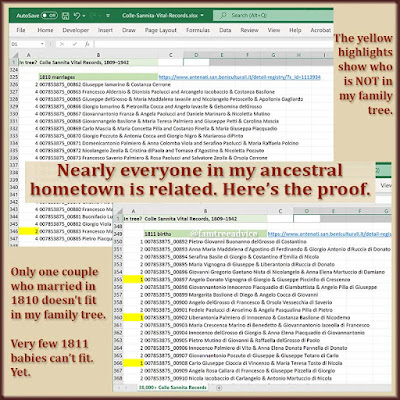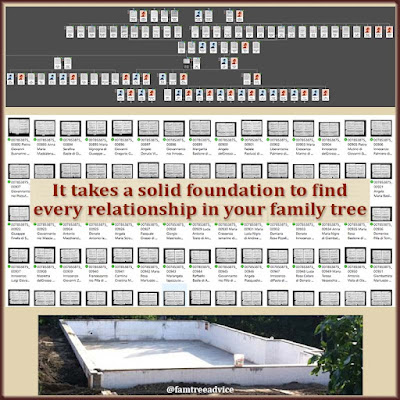You can't skip a generation while building your family tree. You can't find your 3rd great grandparents without your 2nd great grandmother's name. That's why rule #1 of creating a new family tree is, "Start with what you know." You enter yourself, your parents, your grandparents. By doing so, you're starting the foundation of your family tree.
Census records, ship manifests, and draft registration cards were all I needed to build my U.S. family tree. Then I got hungry for more. More relatives, more generations. To expand my family tree further back in time, I needed "old-country" records.
 |
| An audit of vital records from Grandpa's hometown proves how I'm related to almost everyone! |
Today my family tree just topped 37,000 people stretching back to the late 1600s. Are they all my blood relatives? No. In fact, last week I explained how to tally up your different relationships. I had just over 6,000 blood relatives in my family tree.
Who are the other 31,000 people in my tree, you ask? They are in-laws and in-laws' in-laws from my part of Italy. Ironically, I wrote a popular article years ago about who to cut out of your family tree. One of my main rules on who to cut involves in-laws. I add only the parents of an in-law to my family tree and no one else. Take my 1st cousin as an example. Her spouse is in my tree, of course, but I'm not going to research him. I'll add his parents, and that's all.
But for me, the in-law rule does not apply to my Italian nationals. When I reviewed vital records from one ancestral hometown, one thing became clear. Everyone in town had some relation to everyone else. The town was a bit isolated, so intermarriage of families happened over and over again.
If you have deep roots in a place where people stayed put for centuries, this is likely true for you, too.
I expanded my family tree with thousands of townspeople. It seemed there was almost no one in the vital records who didn't have a connection to me. I mentioned this to my husband who wondered, "How many people would be in your tree if you did add them all?" After telling him I couldn't even guess, I wondered what I could do to find the answer.
Reviewing Every Record
For my hometowns, I made spreadsheets of the names of people in every available vital record. What if I added a column and marked who's in my family tree?
Since my tree is so broad already, I'm starting my tally with the earliest records, beginning in 1809. My spreadsheet has a line item for each image downloaded from the Antenati website. I'm adding a number in the new column to show who is in my tree.
Some images have more than one document, so the number of people depends on the image. A two-page marriage image has two pairs of brides and grooms. If both couples fit into my tree, I score that line as 4 for 4 people. If only one couple fits, I score it as 2. A two-page birth image counts as 2 if both babies fit into my tree. I'm not counting the parents because they're going to have a lot of kids.
The tally is more about ensuring that I fit in everyone I can. The sum of these numbers isn't going to be a true count of who went into my family tree. Someone may be counted several times. They're born, they marry (maybe a few times), and they die. They're going to rack up a few numbers, but they're only one person.
What I really want to spot is the people in the documents who can't fit into my family tree. I'm making these people visible by highlighting their lines in yellow. As I scroll down the spreadsheet, any line without yellow tells me those people and their facts are in my tree. As my tree grows, I can always double back and re-check the yellow-highlighted lines. These people may fit into my family tree later.
Proving My Theory
The results so far are fantastic. As I check each document, many of the people are already in my tree. If not, then their parents are in there, and I can now add the child. The people I can't fit are usually from another town or my town's aristocrats. I come from pure peasant stock, so none of my people were marrying into the upper class.
 |
| A broad and solid foundation to your family tree may support your entire ancestral hometown. |
I love the idea of checking the vital records one-by-one. Sometimes I capture a child who died young. Their death record may be the only chance for them to get into my tree. The best outcome is when I find proof that two people in my family tree with the same name are actually the same person. This exercise, which I've only just begun, has given me the proof I needed to merge a bunch of people together.
I'm seeing plenty of interest out there in One-Place Studies—investigating everyone in town to see how they fit together. This is what I've been doing for more than 10 years. Now I'm being methodical about it. As I review each vital record, it reminds me that the answers to many questions are out there. I don't want to overlook any of the clues.
Make sure your family tree has a solid foundation. Climb up each generation carefully. Then expand to your ancestors' siblings. Add their spouses, their spouses' families, and so on. With a broad foundation, you can piece together entire towns. Now you've created something of value to yourself, and to thousands of other people.
Where in-laws are concerned, it depends on how deeply entwined the families are. And if a sibling of someone entering the family on marriage signs as a witness to the marriage, I definitely add them to my tree.
ReplyDeleteI generally add at least the parents of spouses into my tree, especially for a female spouse. But, in some cases, I have gone many generations back because I know they must connect to me somehow, too, based on surname and location.
ReplyDeleteSo far, almost everyone on my Edgefield project connects to our family in some way, but I have started with my husband's family's church, so I guess that isn't so odd. There are two infants that I haven't been able to place. I am looking for information on their parents. I'm sure they will fit in though. :)
Thanks for making my retirement years a whole lot more interesting! You never fail to inspire me with new ideas.